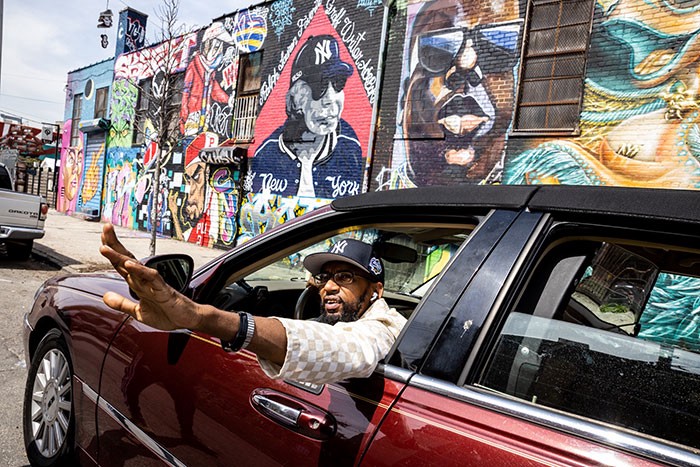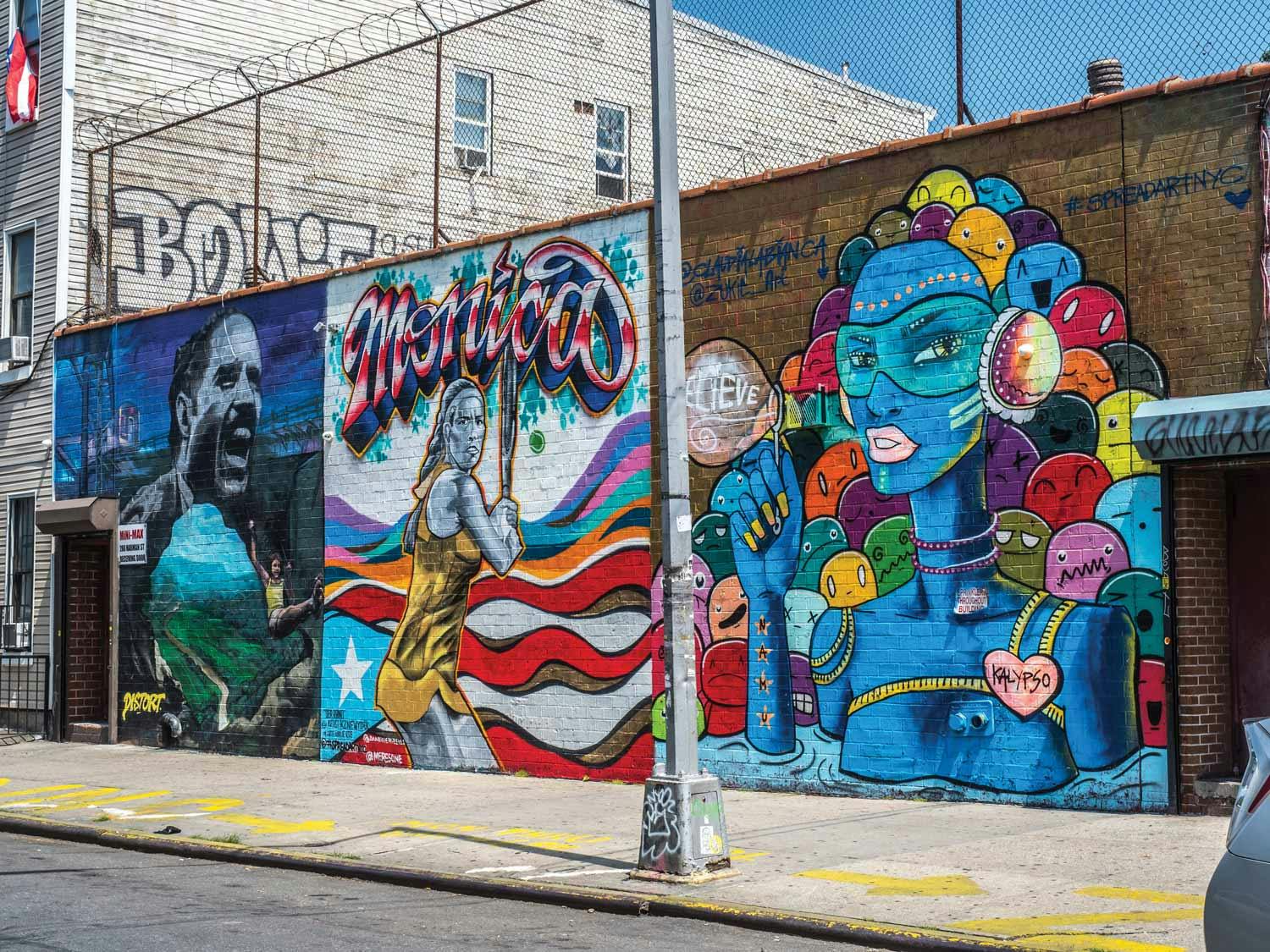How Text Messages Taught me a Lesson in Gentrification
The Textilandia walking tour showed me how Brooklyn’s Bushwick neighborhood has changed.
Murals along the Textilandia walking route—the lefthand panel depicts Puerto Rican independence advocate Pedro Albizu Campos.
On a drizzly, overcast afternoon in late August, I gear up to go for it.
Getting there is gonna be annoying, I think to myself. And I’m going to get soaked.
I’m from Vancouver, but I have lived in Brooklyn for almost a decade. Like most people I know, I rely on the train to get around. Usually that’s fine, but getting from my home in the center of Brooklyn to Bushwick in the borough’s northern tip requires a jaunt on the L Train through Manhattan.
I’m off to Bushwick to partake in an interactive theater experience called Textilandia, described on its website as “[immersing] its audience in the flavors, sounds, sights and dynamic history of a neighborhood confronting social stigmas and the realities of gentrification.” My goals in seeking out this experience? Try something new, learn about an historic neighborhood, and get out of my comfort zone.
I’ve been to Bushwick a handful of times, but I never spent much time there. I don’t know much about it other than the fact I’ve met many Latino individuals over the years that called Bushwick home. According to a 2019 study done by NYU’s urban-policy focused Furman Center, over 56% of Bushwick’s 127,000 residents identified as Hispanic.
Textilandia is a texting-based walking experience that shows participants the neighborhood through the eyes of creator Modesto Flako Jimenez, who grew up there. Jimenez is a multidisciplinary artist who drives a taxi to make ends meet between theater gigs. During April and May of this year, he drove small audiences around Bushwick in his cab in an intimate theater piece called Taxilandia.
As an artist, my goal is to bring people together to start a dialogue over political and social issues critical to our community’s growth.
I’m embarking on its offshoot, Textilandia, a text-based version that was available through September for those of us who didn’t get to ride with Jimenez in person. (An audio taste of the taxi experience is still available thanks to “Bushwick and the Beast,” an episode of the podcast Resistance.)
For Jimenez — who moved to Bushwick from the Dominican Republic when he was just 9 years old — Taxilandia and Textilandia are rooted in his struggles growing up in the neighborhood. He told the Resistance host, Saidu Tejan-Thomas, Jr., that “Erasure is happening to me and my peoples, and the only way I know how to talk is through my art. If not, we’re gonna fight or some weird shit.”

Textilandia creator Flako Jimenez driving through Bushwick, Brooklyn
Jimenez told the Foundation for Contemporary Arts that, “As an artist, I feel my goal is to bring people together to start a dialogue over political and social issues critical to our community’s growth.” It was through this passionate desire — to help preserve his neighborhood’s identity and educate people about its legacy — that his immersive theater experiences were born.
Textilandia aims to capture both the past and the present of a changing neighborhood. And certainly, the neighborhood is changing as a result of gentrification. (Quick refresher: “Gentrification” is when an influx of middle-class and wealthy people enters a historically poor neighborhood, bringing with them building renovations, increased property values, and often increasingly unaffordable rents for long-time tenants.)
The Furman Center also found that between 2000 and 2019 the white population of Bushwick more than doubled, while the Latinx population declined from nearly 68% to just over 56%.
It wasn’t fully gentrified, but it was starting to happen. More and more bougie and expensive places started to pop up.
Though she isn’t present with me on this stroll, that’s something my friend Sharon Davila told me she noticed firsthand. Sharon is from Puerto Rico, but came to New York in 2015 for work. She found her first apartment in Bushwick. “I had just moved to the city, and it felt like home,” she told me. “The barbershop with the bachata or the reggaeton [music]. It minimized the homesickness.”
But things didn’t stay like that for long. “It wasn’t fully gentrified yet, the way that Downtown Brooklyn or Fort Greene is, but it was starting to happen. You could notice on Wyckoff Avenue that things were starting to bump up. Coffee shops, restaurants, bars. More and more bougie and expensive places started to pop up.”
Eventually, she moved to Queens.
But while Sharon was looking for a taste of home in Bushwick, for Jimenez, Bushwick was home. This becomes apparent the minute I start the tour, which begins on a side street just off of one of the neighborhood’s main drags, Knickerbocker Avenue.
I find the location via my free downloadable “ticket,” which directs me to look for the sign with big letters at the listed address on a densely populated residential street similar to many others in the neighborhood.
I find the address and don’t see a sign. I look up a floor. Nothing.
Then on the third level I see something.
O Y E.
Wait, is that it? That has to be it. Is that where he lives? Maybe.
The directions instruct me to text that word to a listed number. This begins the flow of text messages which direct me through an approximately 35-minute stroll through some of Jimenez’ old haunts in Bushwick.
Murals dismantle the idea that art is exclusive.
Two doors down from the starting spot is a wall of vibrant murals featuring prominent Puerto Rican figures, including independence advocate Pedro Albizu Campos, baseball legend Roberto Clemente, and champion boxers and Bushwick natives, sisters Amanda and Cindy Serrano.
Murals are such an important part of Puerto Rican culture and identity. Damaly Gonzalez wrote on HipLatina.com, “Murals are an important form of art accessible to people who usually wouldn’t go to museums. Not only are they necessary, but they also dismantle the idea that art is exclusive.” To me, this wall stands out as a clear beacon of the neighborhood’s deep connection to Puerto Rico.
Textilandia directs me to various destinations while Jimenez offers memories tied to those locales. I can’t remember ever having done anything like this before, and juggling my phone, notebook, and quickly-running-out-of-ink pen while trying to read the directions makes for an extra layer of stimulation.
Hey, at least it isn’t raining anymore.
One of the first stops is the Hope Gardens housing project, which Jimenez notes as an important symbol of white flight (the gradual departure of white populations from urban centers as they become more racially diverse). It happened here in the 1970s and 1980s, when many of the neighborhood’s German and Italian residents moved north to Ridgewood, across the Queens border, or decamped to the suburbs.
The texts I receive point out that these apartments were constructed after the devastating fires of 1977, which torched a large portion of the neighborhood and put a national spotlight on the plight of one of the city’s poorest areas at the time.
White flight happened here in the 1970s and 1980s, when German and Italian residents moved north to Queens, or decamped to the suburbs.
The fire, a result of insurance-fraud-spurred arson and electrical fires in unmaintained buildings, also resulted in looting and a widespread blackout.
A few blocks down, I’m told to stop at the Santa Barbara Roman Catholic Church. The Baroquish-style building, which is currently covered in scaffolding, was originally built in the early 20th century to serve the neighborhood’s German population. However, by the 1960s, it was largely attended by the growing Hispanic population.
Jimenez notes that I should pay close attention to the adjoining building, which houses El Puente (The Bridge) after-school program. He mentions that this was a crucial place for him and other youth in the neighborhood. Homework, snacks, resumé-building, and a safe alternative from the perils of the street were on offer.
Cool name, I decide. Very apt.
Along the walk, Jimenez frequently advises me to use all my senses.
“Breathe it in.”
“Close your eyes.”
“What do you smell?”
“What do you hear?”
At that point, it is mainly cars driving over wet streets. This is an unfamiliar way to learn about and appreciate a neighborhood. But my guide is clearly so passionate about it, and I am starting to pick up on his rhythm and hints. I start listening a little more closely.
I’d heard the term “gentrification” many times. Maybe I’ll never be able to fully internalize it, but at least now I have some stronger reference points and visualizations.
One thing I pick up on on nearly every block is some variety of Spanish-language music or radio blaring out of a car or window. And I mean every block.
I’d heard the term “gentrification” many times. Maybe I’ll never fully internalize it, but now I have stronger reference points.
Whether it is due to the dreary weather, or the lingering impact of the ongoing Covid-19 pandemic, the streets are fairly unpopulated today. The unmistakable pulse of reggaeton and salsa wafting out of the closely packed buildings helps to balance that out a little.
The rest of the stroll highlights a handful of other notable spots for Jimenez and the community: where he got his first job; where he would grab a haircut; where the local dope-slangers would hide their stashes.
I think it may be impossible for a non-native New Yorker to fully comprehend the impact of gentrification, but Jimenez’s unique creation certainly helped me get closer.
“I wrote these letras for us,” Jimenez texts near the end of the tour, “to journey into the past and see the flaws and resilience of the people. Step in the concrete, peep the traces fighting to survive this beast!”
As I head for the L train, I look around and listen for the bachata once more.
Hey, the sun’s out!
Print Issue: Fall/Winter 2021
Print Title: Babbling Brooklyn
